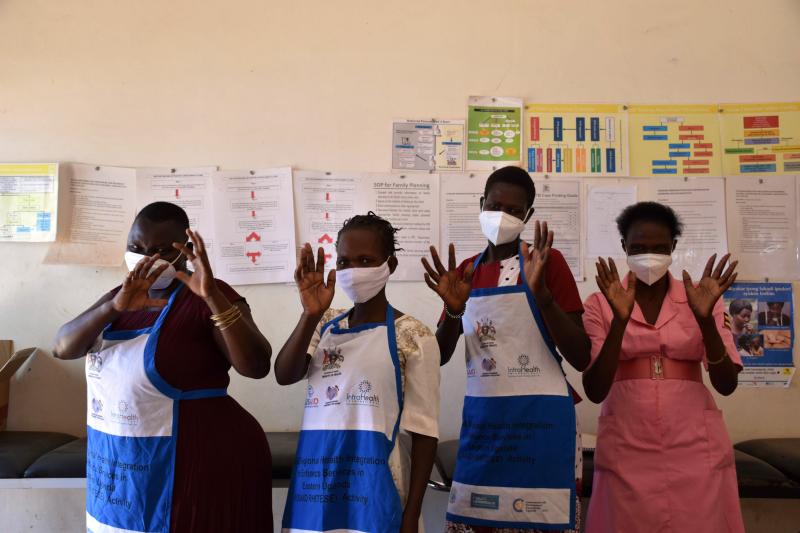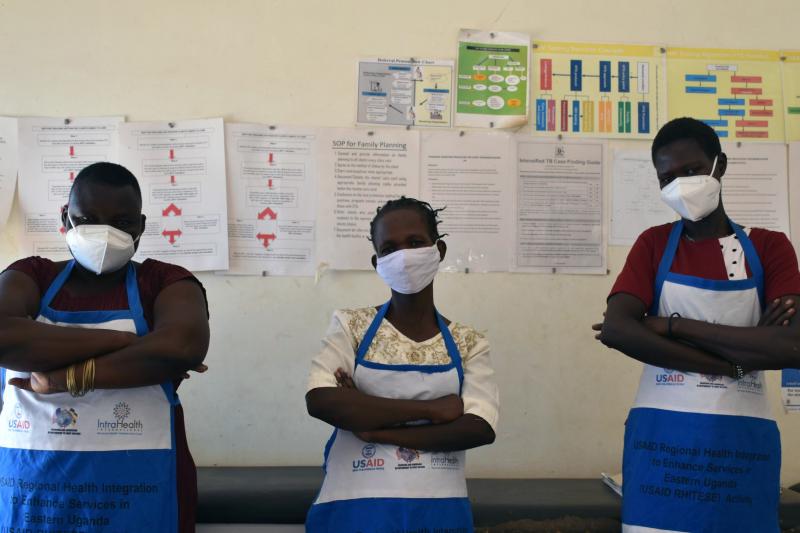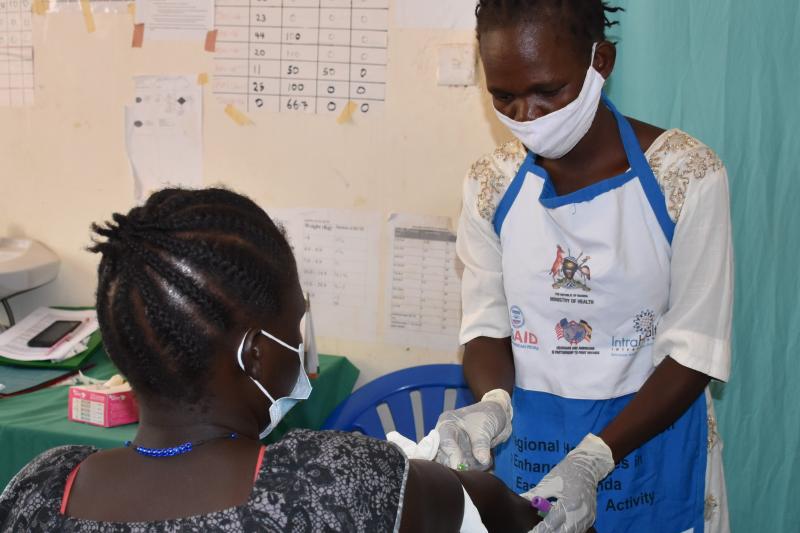Where We Work
See our interactive map


Lucy, Grace, Florence, and Hellen are working together to improve HIV services in Eastern Uganda. Photo by Irene Mirembe for IntraHealth International.
How four women health workers are providing HIV services at one rural health center in Eastern Uganda.
The Kotido Health Center IV HIV clinic in Eastern Uganda is run by a vibrant team of four wonder women. Led by the antiretroviral therapy (ART) clinic “in charge” and mentor Hellen, the quartet of health workers delivers high-quality HIV services for 357 clients—that’s 67% of the entire HIV client base in their district.
Viral load suppression—a key HIV treatment goal, wherein medication reduces the amount of HIV in a person's body to an undetectable level—among clients in the Eastern region has remained at 70%, below the national target of 95%. At the Kotido Health Center IV, the viral load suppression rate is better than the regional average at 77.5% and the average yearly client retention is 93.3%, thanks to Hellen, her team, and support from IntraHealth International’s USAID-funded Regional Health Integration to Enhance Services in Eastern Uganda (RHITES-E) Project.
In Eastern Uganda, among adults ages 15 to 64, the prevalence of HIV is estimated at 5.1%. So RHITES-E implements HIV services in 15 districts in the eastern region and five in the Karamoja Region of Uganda, an area that has a total estimated population of 6.9 million. RHITES-E supports HIV care and treatment services with a focus on interventions that contribute to PEPFAR’s 95-95-95 goals and implements HIV interventions in 219 antiretroviral therapy (ART)-accredited sites across these 20 districts. The viral load suppression rate for all RHITES-E projects in Eastern Uganda is 88%.
The four women at the ART clinic are making enormous strides in HIV care.
RHITES-E supported the Kotido Health Center IV by implementing an electronic medical records (EMR) system for the HIV clinic’s office, which provides real-time updates of patient records and manages and streamlines dataflows to improve decision-making on antiretroviral therapy (ART) and support interventions in the community the clinic serves.
With proper tools and support, the four women at the ART clinic are making enormous strides in HIV care. Working alongside Hellen are counselor Grace Amongin, mentor mother Lucy Longoli, and Florence Bella Akongo, a case manager who focuses on the clinic’s interventions to improve ART enrollment, optimization, retention, and viral load suppression. Together, these four women work to bring back patients who have missed crucial care, deliver antiretroviral medicines to clients at home, and integrate viral load testing in the community.These four women have worked together to improve HIV testing through screening, linking clients to care, providing care and treatment services, and providing services to prevent mother-to-child transmission.
“Today, new HIV patients were successfully enrolled into treatment,” Hellen says. “This achievement is attributed to efforts to keep ART clinics open daily, which encourages same-day ART enrollment, strengthens health worker capacity through training, coaching, and mentorships, and allows for antiretroviral stock availbility.”
RHITES-E uses community structures to deliver last-mile services for HIV/AIDS, family health, and malaria within the supported communities. Members of the community like Grace and Florence are usually selected, trained, and equipped with the necessary job aids and tools to work as mentor mothers, counselors, and case managers.
Lucy, Grace, and Florence. Photo by Irene Mirembe for IntraHealth International.
At the Kotido Health Center IV, RHITES-E works with the community to improve adherence to ART among the clients the Health Center serves. To do this, the clinic conducts reminder phone calls, provides physical escorts to clinic visits, and conducts weekly data reviews to identify missed appointments so the health center can fast-track enrollment of stable clients into appropriate care.
As a result, the clinic has strengthened client follow-up and newly enrolled clients on ART within the first six months of initiation, which has maximized retention and helped clients achieve viral load suppression.
“Now, we are escorting newly identified clients to same-day linkage and are following up on PrEP (pre-exposure prophylaxis medicine)-eligible clients who got lost due to COVID-19 restrictions,” says Lucy, the mentor mother.
RHITES-E continued to partner with the Uganda Ministry of Health to roll out new national HIV prevention and treatment guidelines in 2020. This continued support and collaboration was mainly focused on training, coaching, and mentorships; providing standard operating procedures and guidelines; and engaging health workers and peers to strengthen retention and viral load suppression of clients to reach UNAIDS 95-95-95 goals.
“Seeing happy clients is an added plus—we are saving lives.”
Because of these efforts, RHITES-E linked 97% of newly diagnosed HIV positive clients to HIV care by the end of 2020 and was able to deliver medicine to clients’ homes during the COVID-19 pandemic, ensuring they didn’t miss ART refills and helping them stay on treatment.
”We feel good about our work when we see improvement in viral load suppression among our clients, especially the children and the adolescents,” Apio Hellen Dorcas says. “They are the most vulnerable groups. Our five-kilometer walk from the clinic to their homes to conduct visits and deliver ART refills are so rewarding.
“Seeing happy clients is an added plus—we are saving lives,” Florence adds.

Grace attends to a client at the ART clinic in Kotido, Uganda. Photo by Irene Mirembe for IntraHealth International.
Despite such successes, challenges remain. For example, there is still a lot of stigma and denial around HIV/AIDS in communities, and the clinic has to find innovative ways to provide essential services without perpetuating fear and discrimination. And the COVID-19 pandemic has only made it more difficult for clients to travel to the clinic for refills and support.
“We had to quickly think of ways to do our work differently,” says Florence, the case manager. “One was to stage community interventions, such as community testing, and to visit client homes and integrate other ongoing health services into our care, like immunizations.”
As the result, the clinic was able to strengthen its facility-to-community and community-to-facility links and referrals for comprehensive HIV/AIDS care and support.
RHITES-E continues to work with health facilities in Eastern Uganda to help them integrate services and ensure clients are screened/assessed, counseled, and receive the services they need no matter the entry point. To help reach more clients, RHITES-E continues to identify opportunities to integrate services (such as family planning, malaria testing, and voluntary medical male circumcision) and new methods of screening to reach the right service locations, services, and clients in all of the 56 high-volume health facilities in the region.
The Regional Health Integration to Enhance Services in Eastern Uganda (RHITES-East) program is led by IntraHealth International and funded by the US Agency for International Development.
Statistics for the article were from the Uganda Population-Based HIV Impact Assessment (UPHIA), 2016-2017 (Kampala: ICAP/CDC/MOH, 2017) and the Mid-Year Population Projections (2015-2030), National and Sub National, Uganda Bureau of Statistics (UBOS), April 2019.
Get the latest updates from the blog and eNews




